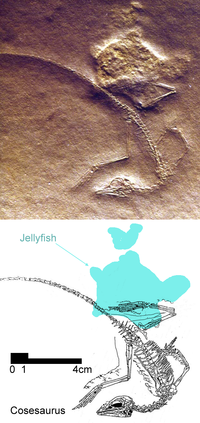- Cosesaurus
-
Cosesaurus
Temporal range: Middle Triassic
Type specimen, with adhering jellyfish Scientific classification 
Kingdom: Animalia Phylum: Chordata Class: Reptilia Order: †Prolacertiformes Genus: †Cosesaurus
Ellenberger & de Villalta 1974Species: †C. aviceps Binomial name Cosesaurus aviceps
Ellenberger & de Villalta 1974Cosesaurus is a genus of prolacertiform archosauromorph reptile. It is known from a single, hand-sized fossil from the middle Triassic period of Spain. The fossil is a perfect impression of a largely articulated and complete specimen preserving soft parts, including an adhering jellyfish, but no bones remain in these impressions.
In 1977, Ellenberger proposed that Cosesaurus was an ancestor of modern birds.[1] That publication followed the description of the bird-like theropod, Deinonychus, but it appeared long before the theropod ancestry of birds had been widely accepted. In his large and highly detailed treatise, Ellenberger interpreted the following traits in the fossil: a strap-like scapula, a furcula (wishbone), a keeled sternum, beak-like jaws, a retroverted pubis and tail feathers. Some of these interpretations have not been supported by subsequent research. Padian and Chiappe (1998) regarded Cosesaurus as a member of the archosauromorph clade Prolacertiformes.[2]
Peters (2000) found that Cosesaurus nested with Sharovipteryx, Longisquama and pterosaurs in a clade, the Fenestrasauria,[3] though at least his inclusion of pterosaurs in this group has not been supported by any other researchers, who criticized his methods as flawed.[4][5] Like Ellenberger (1977), Peters found an antorbital fenestra without a fossa was a shared trait of these taxa, convergent with the antorbital fenestra with fossa found in archosaurs and archosauriformes. Later, Peters (2009) described a small pteroid in Cosesaurus.[6] This was reduced from the fenestrated-type of coracoid found in most lizards and the prehistoric taxon Huehuecuetzpalli, by simply increasing the size of those fenestrations. While a disc-like coracoid is suitable quadrupedal locomotion (all lizards have such a coracoid) stem-like coracoids are better for flapping, as in birds and pterosaurs. This would require at least occasional bipedal locomotion, as in certain lizards. Supporting that hypothesis, the feet of Cosesaurus have been matched to the sometimes bipedal and narrow gauge Triassic Rotodactylus tracks, which are distinguished by the impression of digit 5 far behind the digitigrade impressions of the other toes.[7] Cosesaurus also had four sacral vertebrae, two more than in any lizard. These may have helped support a bipedal configuration by adding strength at the fulcrum located at the hip joint.[3]
References
- ^ Ellenberger, P.-P. (1977). "Quelques precisions sur l'anatomie et la place systematique tres speciale de Cosesaurus aviceps (Ladinien superieur de Montral, Catalogne). Caud. Geologica Iberica, 4: 169-188.
- ^ Padian, K. and Chiappe, L.M. (1998). "The origin and early evolution of birds." Biol. Rev., 73: 1-42,
- ^ a b Peters, D. (2000b). "A Redescription of Four Prolacertiform Genera and Implications for Pterosaur Phylogenesis." Rivista Italiana di Paleontologia e Stratigrafia 106(3): 293–336.
- ^ Hone, D.W., and M.J. Benton. (2007). "An evaluation of the phylogenetic relationships of the pterosaurs among archosauromorph reptiles. Journal of Systematic Palaeontology, 5: 465–469.
- ^ Nesbitt, S.J. (2011). "The early evolution of archosaurs: relationships and the origin of major clades". Bulletin of the American Museum of Natural History 352: 1–292. http://digitallibrary.amnh.org/dspace/bitstream/2246/6112/1/B352.pdf.
- ^ Peters, D. (2009). "A Reinterpretation of pteroid articulation in pterosaurs." Journal of Vertebrate Paleontology 29(4): 1327–1330.
- ^ Peters, D. (2000a). "Description and Interpretation of Interphalangeal Lines in Tetrapods." Ichnos 7:11–41
Categories:
Wikimedia Foundation. 2010.
